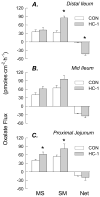A human strain of Oxalobacter (HC-1) promotes enteric oxalate secretion in the small intestine of mice and reduces urinary oxalate excretion
- PMID: 23959075
- PMCID: PMC3815490
- DOI: 10.1007/s00240-013-0601-8
A human strain of Oxalobacter (HC-1) promotes enteric oxalate secretion in the small intestine of mice and reduces urinary oxalate excretion
Abstract
Enteric oxalate secretion that correlated with reductions in urinary oxalate excretion was previously reported in a mouse model of primary hyperoxaluria, and in wild type (WT) mice colonized with a wild rat strain (OXWR) of Oxalobacter (Am J Physiol 300:G461–G469, 2010). Since a human strain of the bacterium is more likely to be clinically used as a probiotic therapeutic, we tested the effects of HC-1 in WT. Following artificial colonization of WT mice with HC-1, the bacteria were confirmed to be present in the large intestine and, unexpectedly, detected in the small intestine for varying periods of time. The main objective of the present study was to determine whether the presence of HC-1 promoted intestinal secretion in the more proximal segments of the gastrointestinal tract. In addition, we determined whether HC-1 colonization led to reductions in urinary oxalate excretion in these mice. The results show that the human Oxalobacter strain promotes a robust net secretion of oxalate in the distal ileum as well as in the caecum and distal colon and these changes in transport correlate with the beneficial effect of reducing renal excretion of oxalate. We conclude that OXWR effects on intestinal oxalate transport and oxalate homeostasis are not unique to the wild rat strain and that, mechanistically, HC-1 has significant potential for use as a probiotic treatment for hyperoxaluria especially if it is also targeted to the upper and lower gastrointestinal tract.
Conflict of interest statement
The authors declared no competing interest.
Figures




References
-
- Hatch M, Cornelius J, Allison M, Sidhu H, Peck A, Freel RW. Oxalobacter sp. reduces urinary oxalate excretion by promoting enteric oxalate secretion. Kidney Int. 2006;69:691–8. - PubMed
-
- Allison MJ, Dawson KA, Mayberry WR, Foss JG. Oxalobacter formigenes gen. nov., sp. nov.: oxalate-degrading anaerobes that inhabit the gastrointestinal tract. Arch Microbiol. 1985;141:1–7. - PubMed
-
- Green ML, Hatch M, Freel RW. Ethylene glycol induces hyperoxaluria without metabolic acidosis in rats. Am J Physiol Renal Physiol. 2005;289:F536–43. - PubMed
-
- Freel RW, Hatch M, Green M, Soleimani M. Ileal oxalate absorption and urinary oxalate excretion are enhanced in Slc26a6 null mice. Am J Physiol Gastrointest Liver Physiol. 2006;290:G719–28. - PubMed
Publication types
MeSH terms
Substances
Grants and funding
LinkOut - more resources
Full Text Sources
Other Literature Sources

